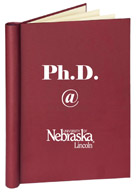Graduate Studies, UNL

Dissertations and Doctoral Documents, University of Nebraska-Lincoln, 2023–
First Advisor
Katherine Frels
Second Advisor
Jeffrey Boehm, Jr.
Degree Name
Doctor of Philosophy (Ph.D.)
Committee Members
Edward Souza, Jeffrey Bradshaw, Reka Howard
Department
Agronomy and Horticulture (Plant Breeding and Genetics)
Date of this Version
5-2025
Document Type
Dissertation
Citation
A dissertation presented to the faculty of the Graduate College at the University of Nebraska in partial fulfillment of requirements for the degree of Doctor of Philosophy
Major: Agronomy and Horticulture (Plant Breeding and Genetics)
Under the supervision of Professors Katherine Frels and Jeffrey Boehm, Jr.
Lincoln, Nebraska, May 2025
Abstract
The wheat stem sawfly (WSS; Cephus cinctus) is an insect pest that affects wheat (Triticum aestivum) in the Northern Great Plains. This pest causes stem cutting that makes the plants susceptible to lodging and results in up to 30% yield loss. The primary management strategy for producers is utilizing host plant resistance, for which the main trait is stem solidness. This trait increases the pith thickness and provides resistance to the WSS by increasing larval mortality and reducing stem cutting. While stem solidness is largely controlled by a known major gene (SSt1), the phenotypic expression is also highly influenced by the environment. Screening for stem solidness and other WSS resistance traits requires destructive and time intensive phenotyping. This dissertation explores approaches to expedite breeding WSS resistant germplasm.
In Chapter 1, I evaluate using multispectral data from uncrewed aerial systems (UAS) to predict stem solidness and WSS infestation rates. I identified significant correlations between WSS traits and spectral data that were temporally and environmentally sensitive. Despite this, prediction accuracy of WSS traits was low and a viable high throughput phenotyping system to replace intensive phenotyping was not identified.
Chapter 2 used a similar approach, but I aimed to predict WSS traits using DNA marker information via genomic selection. I found that prediction accuracy for stem solidness was good and prediction accuracy for WSS infestation was dependent on the overall infestation rate of the environment. Univariate Bayes B models outperformed the GBLUP models, and these models can be deployed to improve WSS resistance traits in the breeding program after validation.
In Chapter 3, I used the ‘Panhandle’ x ‘Wesley’ biparental population to identify QTL associated with WSS infestation, stem solidness, and stem cutting. A total of eight QTL were identified including the SSt1 gene and a potentially novel QTL for stem cutting, QCut.unl-1A. These QTL may provide future breeding targets to improve WSS resistance and biological insight into the impact of WSS.
Advisors: Katherine Frels and Jeffrey Boehm, Jr.
Recommended Citation
Graham, Sydney E., "Integrating Genomic and Phenomic Breeding Tools for Wheat Stem Sawfly Resistance in Hard Winter Wheat" (2025). Dissertations and Doctoral Documents, University of Nebraska-Lincoln, 2023–. 296.
https://digitalcommons.unl.edu/dissunl/296
Included in
Agronomy and Crop Sciences Commons, Entomology Commons, Genomics Commons, Plant Breeding and Genetics Commons, Plant Pathology Commons


Comments
Copyright 2025, Sydney E. Graham. Used by permission